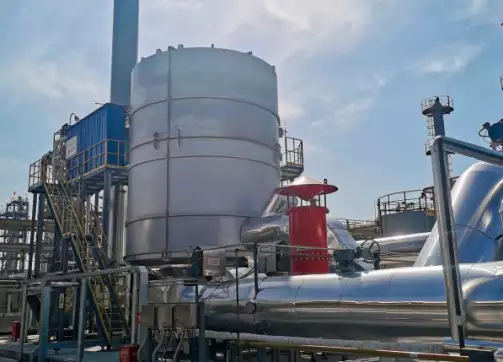Regenerative Thermal Oxidizer Emissions
Introduction
Regenerative Thermal Oxidizer (RTO) is a widely used environmental control technology in various industries to reduce air pollution and control emissions. This article aims to provide an in-depth understanding of RTO emissions and their significance in environmental sustainability.
Understanding RTO Emissions
- RTO Operation and Functionality
- RTO Emission Components
- Chemical Emissions
- Particulate Matter (PM) Emissions
- Nitrogen Oxide (NOx) Emissions
- Environmental Impact of RTO Emissions
An RTO works by utilizing high temperatures to combust volatile organic compounds (VOCs) and hazardous air pollutants (HAPs) emitted during industrial processes. The system consists of ceramic beds that alternately absorb and release heat, maximizing energy efficiency.
RTO emissions can be categorized into three main components:
During the oxidation process, VOCs and HAPs are transformed into carbon dioxide (CO2) and water vapor. This conversion reduces the harmful impact of these pollutants on the environment.
Although RTOs are primarily designed to control gaseous emissions, there can be trace amounts of particulate matter generated. However, the use of proper filtration systems can significantly minimize PM emissions.
In some cases, RTOs may produce NOx emissions due to high combustion temperatures. However, advanced RTO designs and optimized operational parameters can effectively reduce NOx levels.
RTOs play a vital role in minimizing the impact of industrial activities on the environment. Their efficient combustion process reduces harmful emissions, contributing to improved air quality and overall environmental sustainability.
Benefits of RTO Emissions Control
- Compliance with Regulations
- Energy Efficiency
- Improved Air Quality
- Enhanced Sustainability
RTOs are designed to meet stringent environmental regulations imposed by local and international governing bodies. Implementing RTOs ensures that industries comply with emission standards and avoid penalties or legal consequences.
The regenerative process of RTOs allows them to recover and reuse heat, resulting in significant energy savings. This not only reduces operational costs but also supports sustainable practices by minimizing the carbon footprint.
By effectively controlling emissions, RTOs contribute to the reduction of air pollutants, leading to improved air quality in surrounding areas. This benefits both human health and the preservation of ecosystems.
RTOs promote a sustainable approach to industrial operations by minimizing the negative impact on the environment. The use of this emission control technology aligns with the principles of eco-consciousness and responsible resource management.
Conclusion
Regenerative Thermal Oxidizers are an essential tool for industries to mitigate emissions and ensure environmental compliance. By understanding RTO emissions and their significance, we can work towards a greener and healthier future for generations to come.

Company Introduction
We are a high-tech manufacturing enterprise specializing in comprehensive management of volatile organic compound (VOC) exhaust gas and carbon reduction energy-saving technology. Our core technologies include thermal energy, combustion, sealing, and automatic control. We have capabilities in temperature field simulation, air flow field simulation modeling, ceramic heat storage material performance, molecular sieve adsorbent material selection, and VOC high-temperature incineration oxidation testing.
Team Advantages
With a research and development center for RTO technology and exhaust gas carbon reduction engineering technology center in Xi’an, as well as a 30,000 square meter production base in Yangling, we are a leading manufacturer in global RTO equipment and molecular sieve rotary wheel equipment sales. Our core technical team comes from the Liquid Rocket Engine Research Institute of China Academy of Launch Vehicle Technology (CALT). We currently have over 360 employees, including more than 60 R&D technology backbone members, including 3 senior engineers with a doctoral degree in thermodynamics and 27 senior engineers.
Core Products
Our core products include the rotary valve regenerative thermal oxidizer (RTO) and molecular sieve adsorption concentration rotary wheel. With our expertise in environmental protection and thermal energy system engineering, we can provide customers with comprehensive solutions for industrial exhaust gas treatment and carbon reduction energy utilization under various operating conditions.

Certifications and Qualifications
- Intellectual Property Management System Certification
- Quality Management System Certification
- Environmental Management System Certification
- Construction Industry Enterprise Qualification
- High-tech Enterprise
- Patents for Rotary Valve Regenerative Thermal Oxidizer (RTO) and Rotary Wheel Heat Storage Incineration Equipment
- Patent for Plate Zeolite Rotary Wheel
Choosing the Right RTO Equipment

- Consider the Exhaust Gas Volume and Composition: Analyze the volume and composition of the exhaust gas to determine the appropriate RTO equipment capacity and design.
- Evaluate the Temperature Requirements: Assess the temperature range needed for efficient oxidation of VOCs and select an RTO system that can achieve and maintain the required temperatures.
- Assess Space and Installation Constraints: Consider the available space and any installation limitations to ensure the selected RTO equipment can be properly installed and integrated into the facility.
- Consider Energy Efficiency: Evaluate the energy consumption and heat recovery capabilities of different RTO systems to choose an energy-efficient solution that optimizes operational costs.
Our Service Process
- Consultation and Assessment: Conduct preliminary consultations, site visits, and requirement analysis.
- Design and Solution Development: Create customized designs, perform simulation modeling, and conduct solution reviews.
- Production and Manufacturing: Customize production, implement quality control measures, and conduct factory testing.
- Installation and Commissioning: Carry out on-site installation, commissioning, and provide training services.
- After-sales Support: Provide regular maintenance, technical support, and spare parts supply.
We offer a comprehensive one-stop solution and have a professional team dedicated to tailoring RTO solutions for our customers.
Author: Miya
